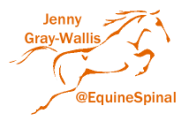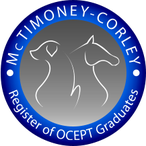Below you can see my promotional video made by MDR Photo, which shows me conducting an assessment and then some treatments to Tradition, one of my clients horses. You can also view the video and find out more on my treatment page.
|
As part of being a McTimoney-Corley practitioner, and the same for any other therapist, animal or human, one of the most important things we do each year is Continuing Professional Development (CPD). This means taking yourself off on courses, doing research, writing papers - however you like to ensure that you are keeping yourself up to date with new & improved methods & techniques for your clients.
This August, I have been to Rose Therapies, (www.rose-therapy.co.uk) based just outside of Chinnor, Oxfordshire to take part in a Myofascial release course for 2 days with Dawn McCaig. This is specifically aimed at Equine Physical therapists of all types. I have to say it was like being back at school - I get quite nervous about meeting new people & worry abit that I might be the least experienced or do something stupid! However, Jo Rose & Dawn made us all really welcome & it was actually brilliant to meet different therapists from all different spheres of the Equine world. There were all sorts of therapists there - Mctimoney-Corley therapist like myself, but also Physiotherapists, Reiki Masters, Equine Body Workers. The first morning involved us doing some background work & class room knowledge - aka 'The Science Bit' and then we went into the therapy room in the afternoon to learn the new techniques, which we were going to practice on each other first before we were let loose on the horses! The myofascial release procedure is a form of soft tissue manipulation used to treat somatic dysfunction and resulting pain and restriction of motion. The fascia is the soft tissue component of the connective tissue that provides support and protection for most structures within the body, including muscle. The idea behind the therapy is maintaining light contact the fascia with relaxed hands. The therapist then slowly stretches the fascia until reaching a barrier/restriction. A light pressure is maintained to stretch the barrier for approximately 3–5 minutes. Prior to release, the therapist will feel a therapeutic pulse (e.g., heat). As the barrier releases, the hand will feel the motion and softening of the tissue. The key is sustained pressure over time. Trying these techniques on each other had some surprising results - we were told about 'emotional unwinding' that can occur during treatment. Often the tissue is restricted or tense when there has been an injury, impact or strain placed upon the body through repeated exercises. When the 'stuck' fascia starts to release, it often reverts to the last remembered position it was in when this restriction first occurred. This can release emotional memories in the patient and trigger muscle memories from particular 'incidents'. I have to say at this point in the lecture, I was wondering what course I had come on! I am a pretty straight forward person but thought I'd paid my money, so to just go with it and see what happened! As we were practicing the 'sinking in' techniques on each other, one of the girls who was having her shoulder worked on started to twitch through her shoulder. The therapist & I kinda giggled to start with as she continued treating. The twitching continued down her arm & before we knew it, her whole arm was shaking, twitching & releasing. The poor girl being treated started to panic a little & Dawn came and took over from the girl treating to slow the 'unwinding' down and bring things back to stability! Both patient & therapist were in tears by this stage! It was pretty intense, but revealed that the patient had had a very nasty fall from a young horse, that flipped over on her and trapped her, crushing this arm. The horse never fully recovered from the fall, but the patient shrugged off the fall as most horsey people do & got on as normal. Just showing us that the body compensates so quickly to injury & damage to allow us to continue with our normal life! Dawn told us that that is highly unusual to happen on a first day, but was a real eye opener! Both patient & therapist were with me in the 'somewhat sceptic' group after the mornings lecture, so just woke us up to a total new way of thinking! We then continued on the second day to working on horses at a local competition yard. There was a real mixed bunch of show jumpers & racehorses which had a variety of tensions & stiffness as busy competition horses would have. There was also some horses with vices on the yard too, so interesting to see what these techniques would result in. We got some really good results from the horses - a huge amount of relaxation, unlocking tension & stiffness's. One particular mare who we assessed heavily for her static & dynamic conformation in the morning, improved hugely with the work done on her. She had quite an awkward gait in walk & obvious pelvis asymmetry. With work, she came out much straighter & had real swing in her walk. It was a hugely beneficial course to take & I have incorporated the new techniques straight away into my usual treatments. The horses really like it & when you start to 'sink in' to the fascia, you can literally feel the tension disperse under you hands. It just takes alot of patience & sometimes looks like you aren't doing much to the owner! |

 RSS Feed
RSS Feed
